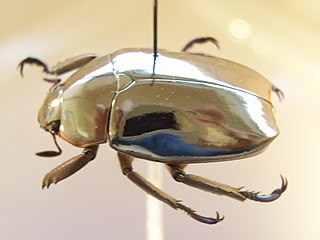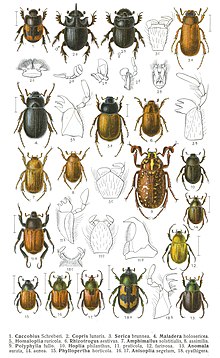
Cetonia aurata, called the rose chafer or the green rose chafer, is a beetle, 20 millimetres long, that has a metallic structurally coloured green and a distinct V-shaped scutellum. The scutellum is the small V-shaped area between the wing cases; it may show several small, irregular, white lines and marks. The underside of the beetle has a coppery colour, and its upper side is sometimes bronze, copper, violet, blue/black, or grey.

Dung beetles are beetles that feed on feces. Some species of dung beetles can bury dung 250 times their own mass in one night.

Scarabaeoidea is a superfamily of beetles, the only subgroup of the infraorder Scarabaeiformia. Around 35,000 species are placed in this superfamily and some 200 new species are described each year. Its constituent families are also undergoing revision presently, and the family list below is only preliminary. This superfamily includes some of the largest beetles extant today, including rhinoceros beetles, (Dynastinae), the Hercules beetle and Goliath beetles.

Dynastinae or rhinoceros beetles are a subfamily of the scarab beetle family (Scarabaeidae). Other common names – some for particular groups of rhinoceros beetles – include Hercules beetles, unicorn beetles or horn beetles. Over 1,500 species and 225 genera of rhinoceros beetles are known.

The scarab beetle subfamily Scarabaeinae consists of species collectively called true dung beetles. Most of the beetles of this subfamily feed exclusively on dung. However, some may feed on decomposing matter including carrion, decaying fruits and fungi. Dung beetles can be placed into three structural guilds based on their method of dung processing namely rollers (telecoprids), dwellers (endocoprids) and tunnelers (paracoprids). Dung removal and burial by dung beetles result in ecological benefits such as soil aeration and fertilization; improved nutrient cycling and uptake by plants, increase in Pasture quality, biological control of pest flies and intestinal parasites and secondary seed dispersal. Well-known members include the genera Scarabaeus and Sisyphus, and Phanaeus vindex.

Aphodiinae is a subfamily of the scarab beetle family, Scarabaeidae. Members of this subfamily are known commonly as the small dung beetles and many, but not all, are dung beetles. These beetles are found worldwide.

Scarabaeus sacer, common name sacred scarab, is the type species of the genus Scarabaeus and the family Scarabaeidae. This dung beetle is native of southern Europe, northern Africa and western Asia, and it was venerated in ancient Egypt.

Melolonthinae is a subfamily of the scarab beetles. It is a very diverse group; distributed over most of the world, it contains over 11,000 species in over 750 genera. Some authors include the scarab subfamilies Euchirinae and Pachypodinae as tribes in the Melolonthinae.

Anomala binotata is a species of shining leaf chafer in the family of scarab beetles, Scarabaeidae. The common name "Shining leaf chafer" is sometimes applied to this species specifically, but is more often used to describe all members of the subfamily Rutelinae.

The European chafer is a beetle of the family Scarabaeidae. Formerly found only in continental Europe, this invasive species is now found at temperate latitudes in North America. The large, white grubs of A. majale feed on the roots of most cool-latitude grasses, both wild and cultivated. This has made the European chafer an enemy of lawns.

Rutelinae or shining leaf chafers is a subfamily of the scarab beetles. It is a very diverse group; distributed over most of the world, it contains some 200 genera with over 4,000 described species in 7 tribes. Several taxa have yet to be described. A few recent classifications include the tribe Hopliini, but this is not generally accepted.

Bolboceratidae is a family of beetle. It was historically treated as a subfamily of the earth-boring dung beetles, or "dor beetles", but has been considered a separate family by many authors since 1995. Some recent classifications have persisted in treating bolboceratids as a subfamily (e.g.) but these classifications are contradicted by recent phylogenetic studies of relationships indicating that bolboceratids are not closely related to geotrupids.

Phanaeus, the rainbow scarabs, is a genus of true dung beetles in the family Scarabaeidae, ranging from the United States to northern Argentina, with the highest species richness in Mexico. Depending on species, they can inhabit a wide range of habitats, from tropical to temperate climates and deserts to rainforests. In those living in relatively arid places adults are primarily active during the wet season and those living in relatively cold places are primarily active during the summer. They are excellent diggers and good fliers.

Pyronota festiva, commonly known as mānuka beetle or mānuka chafer, is a member of the genus Pyronota of the beetle family Scarabaeidae. It is a scarab beetle endemic to New Zealand, and is commonly found in mānuka trees, hence the beetle's name. In some areas it is considered a pasture pest.
Protognathinus is an extinct genus of stag beetle from the Eocene of Europe, known from the Messel Pit in Germany. This genus is known from the single species P. spielbergi.

Chrysina limbata is a species of scarab beetle found only in mid-altitude forests in Costa Rica and western Panama. It is in the genus Chrysina, in the subfamily Rutelinae. It is notable for its metallic reflective silver color.
Gymnetina is a genus of fruit and flower chafers in the family of beetles known as Scarabaeidae. There are about six described species in Gymnetina.
Onthophagus unifasciatus, is a species of true dung beetle native to India and Sri Lanka.

Catharsius pithecius, is a species of dung beetle found in India, Sri Lanka, Pakistan and China.
Oryctoantiquus is a genus of middle Eocene beetles in the Dynastinae clade. Oryctoantiquus is known for being the oldest known genus of Dynastinae and is also known for being the largest discovered Scarabaeidae so far. The genus only has one known species, O. borealis. The species and genus was found in Oregon, United States and dates from around 44.6 million years to 46.8 million years ago in the Clarno formation, middle Eocene epoch.



















